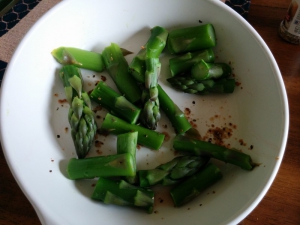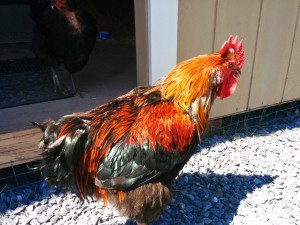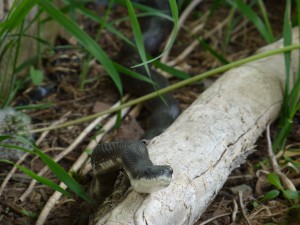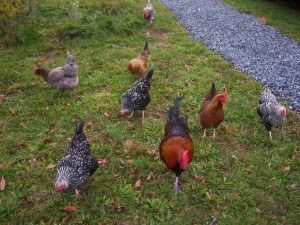Farm

April garden update
0April sure is flying by. We had a little bit of cold weather after the garden was started, but then it warmed up again and everything has started to pop up. Unfortunately, the first ten or so shoots of asparagus came up and got bitten by the cold and kind of died back. This is year four and our plants are now very strong and as soon as it warmed up just a bit the second round of shoots came up and we had our first plate of steamed asparagus a couple of lunches ago.
The spinach came up, but it looked like perhaps slugs got to it, because the tender tip were all eaten. I tried to cover the spinach and the radishes the night before the 22 degrees, but the spinach is just gone. The radishes were chewed up a bit, but survived and now are starting to leaf out nicely. The onions look pretty good as do the snap peas, but the regular peas didn’t seem to germinate as well as they should have. They were pretty much planted directly into the new compost I had delivered and maybe that should have been mixed with some other soil. Yesterday I planted two more rows of regular peas which is three and a half weeks after the first planting. Hopefully they will ripen at least a week or two later then the first row.
I worked hard on the slightly raised bed where I planted potatoes last year and decided to plant it with potatoes again this year. It is a perfect spot for them and the ground is great for digging. I added a layer of chicken manure and added several inches of the new compost. About a third of the plants are just popping up and they look nice and healthy. This year I did half Yukon Gold and half some variety of red potato.
Roundup is everywhere
0Genetically modified crops are so ubiquitous that Roundup is now likely in the air you breathe and in the water you drink. In a study by the U. S. Geological Survey, 3,732 environmental samples were collected between 2001 and 2010 from 38 states.
Findings
- Glyphosate and, or AMPA were detected commonly in surface waters (59 percent of 470 sites), and infrequently in groundwater or soil water (8.4 percent of 820 sites).
- Glyphosate was detected in more than 50 percent of soil and sediment samples, and water samples from ditches and drains, precipitation, large rivers, and streams.
- Glyphosate was detected in less than 40 percent of water samples from lakes, ponds, wetlands.
- AMPA was detected more frequently than glyphosate in all environmental settings except lakes, ponds, and wetlands.
- AMPA was detected in more than 80 percent of wastewater treatment plant samples; while glyphosate was detected in only about 10 percent of those samples.
- Data from nine surface-water sites sampled repeatedly indicate that glyphosate and AMPA detection frequency, median concentrations, and loads are higher late in the study period (2006-2010) than early (2001-2005).
Bummer, but our reality. As usual, I am not worried for myself, but worried for my grandchildren. I hate to think about all the manmade chemicals that will be building up in their bodies for 100 years.
I used to think how nice it would be to have my little farm and to be able to grow my own organic food. Now I look out my kitchen window and see my garden and beyond that see my neighbor’s 20 acres of GM soybeans and think about my grandkids.

A new year
0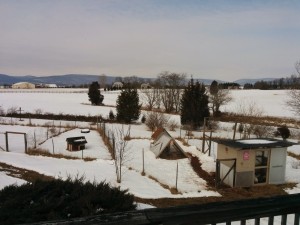 Wow. A whole year has gone by without a post or other update to LLF. Shame on me. I will try to do better this year. The worst part of no updates is that I don’t remember the details of what I planted in the garden and when and what the weather was like and how well the varieties produced. I don’t remember details about the chickens and ducks and my bees.
Wow. A whole year has gone by without a post or other update to LLF. Shame on me. I will try to do better this year. The worst part of no updates is that I don’t remember the details of what I planted in the garden and when and what the weather was like and how well the varieties produced. I don’t remember details about the chickens and ducks and my bees.
I did set up a separate website for a small group of us beekeepers and there was quite a bit of activity on that site. We called ourselves the Honeybee Wranglers and as 2015 progresses we will hopefully build on that information. It has been a long and cold winter just like last year. Maybe not as much snow, but just as long and cold. It is tough for the bees to keep warm and protect the queen and the little bit of brood she may have started producing. So I may not post much about the bees here on the LLF main site, but I will continue to contribute to the Honeybee Wranglers.
In summary, we didn’t do much new with our chickens. We had two chickens die last week. Duran who had some neurological problems in the middle of last year and whom we kept separated from Big Red all fall was found one morning with a very full and hard crop and slumped in the corner of his enclosure. We tended to him in the house for about 24 hours, but he didn’t make it. And then a few days later one of the younger hens was found dead on the floor when we went to open things up in the morning. There was a few other losses over the year. We lost a guinea a few weeks ago – literally lost- as she just disappeared. The guineas can fly out of their yard and perhaps she just got spooked and flew off somewhere and never found her way back. We are down to four now.
We lost a duck to a hawk in early December when we were on a trip to Ohio. Our house sitter called us as we were driving west to give us the news. There were at least two more deaths in the fall. They were only a week or so apart, so I took the second one to the animal health lab for a necropsy and it was determined that she had ILT (Infectious Laryngotracheitis). The state chicken inspector paid us a visit and took cultures (oral swabs) from five birds in each of our three coops. Only the coop where the two chickens died came back positive for ILT, but as a result we were quarantined for two or three months. This means that we take any of our birds off the property during that time. The ban was lifted at the beginning of this year, so we are free to show our championship foul at all the local competitions. Ha ha – not something we do anyway. The virus that causes ILT is a herpes virus and so will be with the birds for life and can be transmitted to other birds. We never saw any of the usual signs of sickness in our flock, but the virus can become life threatening if the birds are ever stressed.

One cold winter
0We are having a very cold winter with quite a bit of snow. It has never been more than 18 inches, but because it is so cold the snow has been persistent. Talk to anyone in Maryland and they will tell you they have had enough winter for this year. We had a brief respite from the cold a few weeks ago amounting to a day or two in the forties and this past weekend we had a couple of days in the 50s. A lot of the snow melted over the weekend, but there is still a ways to go. Now, when it is above freezing, we have puddles and mud. Lots of mud.
Honeybees
I went into the winter with three hives that were pretty strong. A three year hive (#1), a 2013 package hive (#2), and a captured swarm from hive 1 (#3). They each had plenty of honey going into the winter, but by Jan hive #1 looked rather weak. I couldn’t see down inside the boxes very well, but there was just a softball sized cluster up at the top of the top frames. I was thinking that this hive wouldn’t make it through the winter. Hive #2 and #3 looked very strong.
I checked again in late Jan and early Feb and things looked the same. Somehow hive #1 was hanging on. I can’t do much with the hives because of my back surgery in late Jan. I just checked this past Sat, Feb 22 and found hive #2 dead. This is a very discouraging finding. I haven’t torn it apart yet, but don’t see dead bees on the ground. I’ll have to check inside the boxes. I pulled out the frame in the center of the top box and it was completely full of capped honey, so they didn’t starve. This hive had the largest population going into the fall and winter, but I didn’t requeen (like I had originally planned to do) and I suspect that this was a big mistake. I don’t ever want to go into the fall and have the queen make her winter workers from southern stock. Amid the bad news was the surprise good news that hive #1 is still alive. The little softball cluster moves around somewhat, but looks about the same. I added candy to hives #1 and #3. On a really warm day, I should probably check the honey stores in hive #1, but based on the small cluster, I imagine they have plenty of honey.

An eventful day on the farm
0Yesterday was quite a day here at Little Lucey Farm. (disclaimer: We’re not really a working farm. We just like to play at it.)
Chickens
In the morning the first order of business is to let the dogs out. It looked like we were going to get a beautiful Sunday to work in the yard. I went to the chicken palace and let the birds out and gave them some scratch. We still have two roosters in with the 17 hens and five guineas. The two roosters continue to get along pretty well. Every once in a while there is a little scirmish, but generally they give each other some space. Big Red is clearly the boss rooster, but Duran can hold his own. We have two broody hens: Daisy, who has been in a nest box for at least two week might be ready to give it up soon, and the larger of the two Barred Rocks who has been in a box for about a week. This is a little bit frustrating, because if we had the Maran rooster and hens in the nursery coop like we wanted, then we could give those eggs to one of the broody hens to raise. The ducks had another idea. Maybe in a couple more weeks we can start the process of raising some pure marans birds.
I opened the original coop to let out those 14 hens and Freddie. These are our four year old birds and the one we handled the most and therefore the most friendly. Tilda and Gertie and Gladys are particularly nice hens. These girls are still laying very well. We’re not sure how long they will keep it up, but so far they are doing great.
We had three yards of mulch delivered a couple of days ago and yesterday we continued to weed and clear out some areas so we could spread the mulch. We are having a party next Saturday, so we were working around the deck. We mulched around the new barrel planters and planted some hens and chicks along the cinder block border that leads to the bees. I was also preparing the garden in order to plant the asparagus that we bought. I never got the tiller running this year, so I was doing all the digging by hand. We were just about finished with the mulching in that area when Joni yelled for me to look at the bees. They had just started to swarm!
Bees
I had my phone which was miraculously charged and was able to get some video. We had never seen the swarming process from start to finish. It only took about 15 minutes, but it was pretty cool to watch. They came out of the hive and swirled up and out in front of the hive and formed a large ‘cloud’ of bees. I got some video from several vantage points. It was spectacular. I suppose their landing spot was never in doubt, but I was watching so I would know where they gathered. Naturally, it was the ‘regular’ spot. It was the same small tree and wild raspberry tangle that all five swarms from last year had used. I really should sell little cuttings or seedling of my magic bee-magnet tree. It clearly has magical powers.
I took seven videos. The second one is shown, but you can watch them all if you are interested. They are only a minute or two each:
Video 1
Video 2
Video 3
Video 4
Video 5
Video 6
Video 7
I let them settle for about a half hour and when I went back to the hives, it looked like business as usual. If I hadn’t seen the swarm, I might have never even noticed. The swarm was very quiet. The bees were still settling down and it didn’t look like the scouts were out in large numbers yet. It was also hidden pretty well in the shrubbery. I had to cut away a lot of the brambles to expose the swarm, but once I did that, it looked like it would be an easy operation. With Joni’s help, we cut the branch from the tree and carried it over to the empty hive box already set up and ready for bees. One shake was all it took, and the bees were in the box – and all over the outside as well. I didn’t want to use smoke to get them to retreat into the box because the bees need to spread the queen’s scent to pull the bees in. I was pretty sure the queen was in the box, so I tried to brush the bees away from the top and was able to get an inner cover on the box. In short order, it was clear that bees were heading in through the front entrance, so the job was almost done.
Last year, I think I had a newly installed swarm reswarm after a few weeks, so this time I wanted to be sure the bees had plenty of space. I decided to put a second deep on right away. Another difference from last year is that these boxes already had frames with comb and perhaps even some old honey or almost honey that went through the winter. There is some risk that there could be some wax moths in these frames, so I will keep a close eye out for them. In the meantime, I will take some other frames and put them in the freezer to kill any wax moths that might be hiding. I still have five or six deep frames from my hive #2 that went through the winter with capped honey in them. I thing the best course of action is to try to feed these back to the bees, so I will try a couple of different things toward this end. Today I will simply scratch open one frame of capped honey onto a cookie sheet to see if the bees will go after that. I suspect they will, but if not maybe either the honey is ‘bad’ in some way or maybe they are still foraging (and preferring) the nectar they are finding in the neighborhood.
Ducks
Dee Dee hatched 10 of her 13 eggs two weeks ago and we felt the need to move them to the nursery coop for protection against snakes. So, unfortunately, the nursery coop is being occupied for another couple of weeks. They have really grown and are very cute. Dee Dee is very protective and generally won’t let us near her babies, but yesterday we wanted to see if they would come out of the coop and take their first swim. We filled a tub with water and with a little help all but one made it into the water. Momma let the way. Normally, duck would like to be swimming a lot, certainly a portion of every day, but Dee Dee has been sitting on her nest for a month and now taking care of little ones with not swimming available – until yesterday. It was clear that she was enjoying the bath.
Wildlife
There was a sad moment in the day, too. We knew that a pair of bluebirds had made a nest in a nest box that has been in the yard for several years. We have watched one or two sets of eggs hatch from that box each year. I had seen eggs in the box a few weeks ago and I thought we would take a look to see if the babies had hatched. When we looked in the box we found three tiny dead baby bluebirds. They looked to me to be less than a week old. There was no sign of mommy or daddy bird. Bluebirds are capable of raising young even if one parent dies. Either parent can do the job. This is especially sad and perplexing. Something must have happened to both parents. And two of the eggs or babies were missing as well. We have a snake guard on the pole, so we don’t think it was a snake, but we just don’t know what happened.

Snake time
0We have a lot of snakes around our farm and we like them. Either garter snakes or larger black rat snakes. This fine fellow showed up a couple of days ago and he was quite friendly. Joni moved him about 100 yards from the house, but he will be back. Normally, we would just leave him alone, but because the baby ducklings were due, we didn’t want the snake to think we were offering up any snacks. We have now moved the ducks into a more secure coop that a large snake could not get into, so he is welcome to return. We have found a couple of large snake sloughs recently, so this guy is not the only one in town.

Meet the Raven
0We bought a new tractor, it came yesterday, and it’s called the Raven. It is a hybrid. It cost a little more than a standard garden tractor, but it’s cool. It’s also a new product which is a risk. Let’s go over the pros and cons.
PROS
- hybrid – uses less gas, fewer emissions, more efficient
- comfortable and spacious
- drives like a car – accellerator and brake, variable speed
- generator
- ATV mode goes 17 mph
- small cargo area in back
- easy to remove mowing deck and blades
- no belts
- large front tires
CONS
- more expensive than garden tractor
- only 46 – inch cut
- new product, unproven
The last ‘con’ is a big one. Doing some research on the internet revealed some problems with the initial release (only about one month ago). For instance there was a cheap seat detection switch that had given some owners a problem. To their credit, the company, Denver Global Products (DGP), came up with a better switch and better mounting to eliminate that problem. My Raven, only a month later already has this modification installed.

The honeybees love quince
1The quince along the driveway is in full bloom and the honeybees have found it. This is the first plant on my property this spring that the bees seem to really love. I have about 20 or 30 yards of bushes along the driveway and there are always lots of bees on the bushes. Yesterday I took a bunch of pictures, so here is a little slideshow with 12 pictures of the bees enjoying the quince. Click on the first picture to get the large images. It’s hard to spot the bees otherwise.

Mild Winter
0We are having the mildest winter that I can remember. The only real snow was in October and most of February felt like April. Yesterday was 70 degrees.
Chickens
The spring projects are starting to pile up. We need to fence off another yard for the chickens. The new birds have eaten all the grass down to the nubs, but I think it will come back if we can put the chickens in the new area soon. I will have to put in six or 8 posts and another 150 to 200 feet of fencing. This new yard is where the tractor was working during the excavation for the chicken palace, and there are big ruts everywhere. I want to try to fill in most of those ruts and then mow the tall winter grass down. That is a couple of weekends, right there.
Google photo album: Chickens 2012
The next project is to build a new nursery coop so we can put a setting hen in a quiet place to raise some babies. We will need to get rid of Tarick the feisty rooster who terrorizes Percy, but seems to lack the instinct to protect his hens. When Tarick is gone we can split up Duran and Big Red and give those hens a break. With the two roosters together the hens are getting pretty beat up.
One of the hens has developed a taste for eggs. Not good. I think it is either Pearl or Bonnie or Violet. All three are Marans. They lay the chocolate brown eggs and I would hate to have to get rid of one of them, but we don’t want to let this behavior continue. We want to raise Marans chicks, however, so we will hopefully have a new supply of Maran egg layers by fall. I wonder if that trait of eating eggs is hereditary.
We have seven new peeps arriving around April 8. We are getting three new Ameraucanas, two Brahmas, and two Barred Rocks.
Still no eggs from the guineas, so they must all be males. They are now able to fly over the fence and they wander around, but never go too far away and always want to go back into the coop at night to roost. They are great ‘watch birds’ – squawking at anything new or different – but they are not producing anything of value, except perhaps some fertilizer.
Honeybees
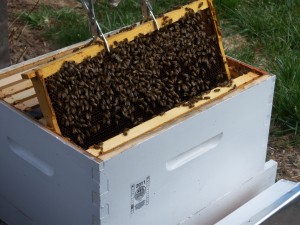 Yesterday I did a big spring inspection. For the first time since adding the second brood boxes to my two hives last summer, I inspected both the upper and the lower boxes. Boston, always the busier hive, had more bees, still lots of honey, some new brood and a little space to expand on the outer frames. I switched the boxes, putting the lower box on top. It was definitely lighter and had more space. I took some pictures as I went and the whole process took about 45 minutes. Because it was 70 degrees, I don’t think the bees minded too much. I never saw either queen, but there was new brood, so she is laying. As careful as I could be, there are still casualties replacing frames and moving boxes around like I did, and I can only hope that the queen is OK. There is always that risk. I didn’t swap the boxes on Anaheim hive, as there was more room in the top box, but I think I will swap them in a few weeks.
Yesterday I did a big spring inspection. For the first time since adding the second brood boxes to my two hives last summer, I inspected both the upper and the lower boxes. Boston, always the busier hive, had more bees, still lots of honey, some new brood and a little space to expand on the outer frames. I switched the boxes, putting the lower box on top. It was definitely lighter and had more space. I took some pictures as I went and the whole process took about 45 minutes. Because it was 70 degrees, I don’t think the bees minded too much. I never saw either queen, but there was new brood, so she is laying. As careful as I could be, there are still casualties replacing frames and moving boxes around like I did, and I can only hope that the queen is OK. There is always that risk. I didn’t swap the boxes on Anaheim hive, as there was more room in the top box, but I think I will swap them in a few weeks.
Google photo album: Honeybees 2012 Mar
Because of the warm winter, the new packages coming from Georgia will be arriving this weekend which is a couple of weeks earlier than usual. I still need to put some deep frames together, but otherwise I am ready for them. Because of the early start, I will need to feed them a lot until the nectar flow starts. I am really hoping for a strong flow and good weather during the Black Locust bloom. Losses of hives is typically in the 30% to 40% range, but it looks like my two made it. It’s a little too early to be sure, but unless we get an extended cold snap, I feel pretty good about my hives making it.
